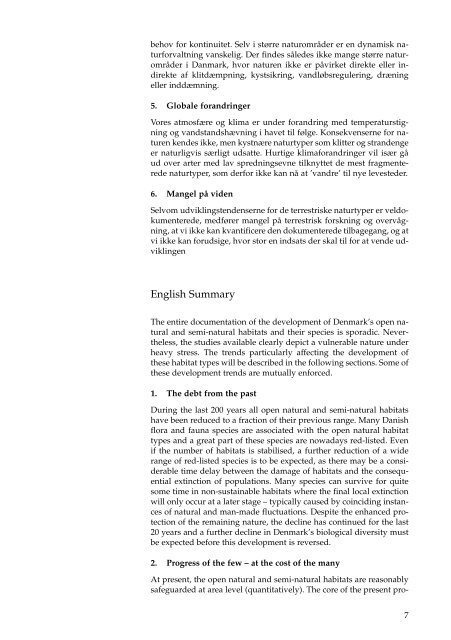Det lysåbne landskab - DCE - Nationalt Center for Miljø og Energi
Det lysåbne landskab - DCE - Nationalt Center for Miljø og Energi
Det lysåbne landskab - DCE - Nationalt Center for Miljø og Energi
You also want an ePaper? Increase the reach of your titles
YUMPU automatically turns print PDFs into web optimized ePapers that Google loves.
ehov <strong>for</strong> kontinuitet. Selv i større naturområder er en dynamisk natur<strong>for</strong>valtning<br />
vanskelig. Der findes således ikke mange større naturområder<br />
i Danmark, hvor naturen ikke er påvirket direkte eller indirekte<br />
af klitdæmpning, kystsikring, vandløbsregulering, dræning<br />
eller inddæmning.<br />
5. Globale <strong>for</strong>andringer<br />
Vores atmosfære <strong>og</strong> klima er under <strong>for</strong>andring med temperaturstigning<br />
<strong>og</strong> vandstandshævning i havet til følge. Konsekvenserne <strong>for</strong> naturen<br />
kendes ikke, men kystnære naturtyper som klitter <strong>og</strong> strandenge<br />
er naturligvis særligt udsatte. Hurtige klima<strong>for</strong>andringer vil især gå<br />
ud over arter med lav spredningsevne tilknyttet de mest fragmenterede<br />
naturtyper, som der<strong>for</strong> ikke kan nå at ’vandre’ til nye levesteder.<br />
6. Mangel på viden<br />
Selvom udviklingstendenserne <strong>for</strong> de terrestriske naturtyper er veldokumenterede,<br />
medfører mangel på terrestrisk <strong>for</strong>skning <strong>og</strong> overvågning,<br />
at vi ikke kan kvantificere den dokumenterede tilbagegang, <strong>og</strong> at<br />
vi ikke kan <strong>for</strong>udsige, hvor stor en indsats der skal til <strong>for</strong> at vende udviklingen<br />
English Summary<br />
The entire documentation of the development of Denmark’s open natural<br />
and semi-natural habitats and their species is sporadic. Nevertheless,<br />
the studies available clearly depict a vulnerable nature under<br />
heavy stress. The trends particularly affecting the development of<br />
these habitat types will be described in the following sections. Some of<br />
these development trends are mutually en<strong>for</strong>ced.<br />
1. The debt from the past<br />
During the last 200 years all open natural and semi-natural habitats<br />
have been reduced to a fraction of their previous range. Many Danish<br />
flora and fauna species are associated with the open natural habitat<br />
types and a great part of these species are nowadays red-listed. Even<br />
if the number of habitats is stabilised, a further reduction of a wide<br />
range of red-listed species is to be expected, as there may be a considerable<br />
time delay between the damage of habitats and the consequential<br />
extinction of populations. Many species can survive <strong>for</strong> quite<br />
some time in non-sustainable habitats where the final local extinction<br />
will only occur at a later stage – typically caused by coinciding instances<br />
of natural and man-made fluctuations. Despite the enhanced protection<br />
of the remaining nature, the decline has continued <strong>for</strong> the last<br />
20 years and a further decline in Denmark’s biol<strong>og</strong>ical diversity must<br />
be expected be<strong>for</strong>e this development is reversed.<br />
2. Pr<strong>og</strong>ress of the few – at the cost of the many<br />
At present, the open natural and semi-natural habitats are reasonably<br />
safeguarded at area level (quantitatively). The core of the present pro-<br />
7
















